It’s no secret that the American meat supply chain has been seriously harmed by COVID-19. Nonetheless, the CDC insists that despite the turmoil of the shutdowns and shortages, our meat remains safe to eat.
But an investigation by The Prepared suggests otherwise:
- We’ve learned that many large US meat processing plants have sought and obtained permission from the FDA to increase their line speed — a potentially dangerous move even without the current coronavirus-induced staff shortages added in.
- Some of the same plants that have gotten the go-ahead to speed up their lines have also been hit hard by COVID-19, with shutdowns due to workers falling ill and even dying.
- These plants have now been forced to reopen by the government, with their workers ordered back to work despite the danger from COVID-19.
- On top of all the sped-up lines and the worker safety concerns, some 300 USDA meat inspectors have recently been taken out of the workforce by COVID-19.
This situation has all the ingredients for an unsafe meat supply, as deregulated meat processors and their overburdened, understaffed workforces cut corners on critical food inspections in the name of staying open and preventing another national meat shortage.
Could the meat produced under this kind of stress on our already vulnerable system really be safe?
As of today, over 14,600 food system workers (meatpacking, food processing, and farm workers) have tested positive for Covid-19, per my analysis for @FERNnews. 57 workers have died. Outbreaks have occurred at over 200 plants. https://t.co/kOeWhGazYE pic.twitter.com/3Nbei3op3o
— Leah Douglas (@leahjdouglas) May 12, 2020
Industry academics express confidence in meat safety
We spoke to food scientist Dr. Gretchen Mafi, who researches meat quality and cutability at Oklahoma State University, to find out how experts are thinking about meat safety right now.
“As a consumer myself, and as a meat scientist, I have 100% confidence in our system.” Mafi said. “I have no fears of eating out, of what I purchase at retail or at restaurants. I have not changed my cooking habits and I don’t see any need for different precautions during this time than I did before.”
Dr. Mafi said the USDA is trained very well to provide what she called “the safest food supply in the world.” She said the USDA has an excellent system for monitoring meat quality and testing for pathogens.
Yes, there have been lots of cases in meat processing plants, but Dr. Mafi said we can trust meat companies to take precautions to increase safety. “The plants have taken steps,” Dr. Mafi said. “If there are fewer employees, they have to run slower. All the inspection requirements are still in place.”
We then asked Dr. Mafi to weigh in on a report from The Guardian that indicated the opposite. Instead of slowing down meat production as plants close and workers get sick, the USDA has actually given processors permission to increase line speed. That’s despite warnings that meat safety could be compromised.
“USDA-FSIS operates to ensure a safe, wholesome product,” Dr. Mafi replied via email when asked about the report. “Measures are in place that continually monitor and analyze potential hazards and eliminate those if found.”
Another expert we talked to echoed Mafi’s confidence in the safety of the meat supply. “I don’t think there are any elevated food safety concerns,” said Purdue agricultural economist Jayson Lusk via email.
But we weren’t convinced, so we did some more digging into the line speedups.
Calculating meat safety ourselves
We may not be able to get definitive information about how processing plants are managing risks associated with COVID-19. But we can put some information together from COVID-19 reports, plant closures and reopenings, and Food Safety and Inspection Service (FSIS) reports.
If the speed of production is a concern, it’s relatively simple to figure out if plants have increased line speed despite coronavirus infections. The first thing to look at is participation in the FSIS Salmonella Initiative Program (SIP). In exchange for food safety data, plants that participate in the SIP program get waivers for regulatory requirements. FSIS reports those waivers, so we can figure out which plants have permission to speed up production, and when they got that permission.
Then, we can use the USDA’s establishment registry to figure out where these plants are and how they’ve done with salmonella in the past year. Finally, to get a sense of the stress on these plants during COVID-19, we can take a look at the Food and Environment Reporting Network’s COVID-19 map to match those plants with coronavirus outbreaks.
Analysis reveals safety is not a priority
The SIP program report shows that sixteen poultry plants have received line speed waivers since the beginning of the coronavirus pandemic. The plants include Foster Farms, Tyson Foods, Inc., Wayne Farms, LLC, Mountaire Farms, Inc., and George’s Processing, Inc.
Just one beef plant has gotten a waiver, but it encompasses far more—inspection staffing, scheduling, spacing, handling of bruised parts, line speed, and generic E. coli testing.
Now comes the tricky part—figuring out where those plants are and whether or not they’ve reported COVID-19 cases. For that, we look to the COVID-19 map and put it all together. Here are the plants that we found are operating with cases of COVID-19 and increased line speeds:
- Foster Farms in Kelso, WA (9 COVID-19 cases, waiver in March)
- Tyson Foods in Forest, MS (1 COVID-19 death, waiver in April)
- Wayne Farms in Albertsville, AL (1 COVID-19 death, 75 COVID-19 cases, waiver in April)
- Tyson Foods in Robards, KY (74 COVID-19 cases, waiver in April)
- Mountaire Farms in Lumber Bridge, NC (9 COVID-19 cases, waiver in April)
Notably, the one beef plant that got a waiver for inspection staffing, scheduling, spacing, handling of bruised parts, line speed, and E. coli testing in March has also been impacted by COVID-19. That’s the Tyson Foods beef plant in Holcomb, KS. It’s reported 87 cases of COVID-19 so far.
Since the coronavirus pandemic reached the United States, five poultry plants and one beef plant have been authorized to speed up production even as they report cases of COVID-19 (and even deaths) among their employees.
Why does line speed matter?
Like Dr. Mafi, we assumed that if meat and poultry plants started getting cases of COVID-19, they’d slow down production. That would make sense. Clean up the processing plant, operate with a reduced workforce, and move slower to guarantee everyone’s safety.
Now, it’s possible that the plants in Washington, Missouri, Alabama, Kentucky, North Carolina, and Kansas are doing just that. It’s possible that the plants are not using the waivers the FSIS has issued. But since these waivers have all been asked for and issued since March, that seems unlikely.
Instead, these plants are probably increasing line speed to avoid blame for meat shortages.
Line speed isn’t the only measure of whether or not a plant is operating safely, but it’s an important one. These increased line speeds can be incredibly dangerous for workers. A spokesperson for the United Food and Commercial Workers told The Counter earlier in April:
Faster line speeds in the poultry plants are dangerous for workers. Line speeds in poultry plants can already move at an insanely fast 140 birds per minute …. For the USDA to grant waivers one-by-one to allow them to engage in this hazardous practice is a risky mistake.
Worker safety was already a concern before COVID-19 came along. In 2016, the Government Accountability Office (GAO) released a report on work hazards in the meat and poultry industry. In interviews with workers and inspectors, GAO found that while inspection injuries vary, “inspectors in poultry plants sustain more repetitive motion injuries due to faster line speeds.”
Is it possible to get safe meat right now?
Given the picture painted by our reporting, we’d be skeptical of any industrial meat product right now. It’s hard to know exactly where any given package of boneless skinless chicken breasts has been processed. And we already know that multiple meat and poultry plants around the country are operating recklessly, so it’s hard to trust that the meat you’re buying has been properly inspected and is truly safe to eat.
As is so often the case, small producers are probably the safest bet right now. Some other advantages to shopping for beef and poultry from smaller outlets: fewer customers who might expose you to COVID-19, and some farms and small butchers even deliver.


You are reporting the comment """ by on